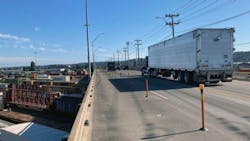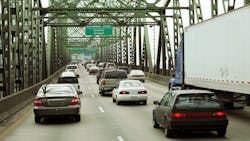Bridge planning grants preview 23 locations where trucking could be aided
Early planning grants for 23 bridge projects in 23 states might mean trucking companies' and professional drivers’ jobs at those locations just got easier.
The $18.4 million—a drop in the bucket compared to the billions that will be required to complete the infrastructure at those locations—were announced by the U.S. Department of Transportation’s Federal Highway Administration (FHWA) last week in the first round of grants from the Bridge Investment Program in the Infrastructure Investment and Jobs Act, which President Biden signed into law almost a year ago.
See also: ATRI reveals top truck bottlenecks for 2022
The early planning grants will help fund early phases of project development in local and state planning offices to create a pipeline of bridge construction projects, according to an Oct. 12 U.S. DOT release.
Of the $18.4 million, the largest single portion, $2.4 million, will go to the City of Seattle to plan the replacement of the 4th Ave S Bridge over the Argo Railyard there, following a previous seismic retrofit that identified replacement was the best of several options for the span, which was built in 1933. Work on that bridge, which is heavily trafficked by commercial vehicles and is a significant intermodal connector, has been complicated by railroad ownership of the rights of way under the bridge as replacing it will disrupt rail-yard operations.
That span, more than a century old, also is a major crossing for truck traffic. Maintaining it costs $1.2 million per year, split between ODOT and the Washington Department of Transportation (WDOT), according to a WDOT release. Maintenance alone to keep the aging I-5 Bridge, which is at risk of collapse in an earthquake in the seismically active Pacific Northwest, in service is expected to run $280 million through the year 2040. Replacing it is expected to cost $3.2 billion to $4.8 billion.
See also: Buttigieg touts infrastructure law, port efforts to unclog supply chain
In two major East Coast urban settings, New York City will receive $1.6 million of the federal grants for the planning and development of a 30-year capital construction program for four iconic East River spans: the Brooklyn Bridge, the Manhattan Bridge, the Williamsburg Bridge, and the Queensboro Bridge. Meanwhile, in Philadelphia, the city will receive $1.56 million for a planning and feasibility study to rehabilitate 18 bridges located over electrified rail lines primarily operated by Amtrak and the Southeastern Pennsylvania Transit Authority (SEPTA).
Other DOT targets for infrastructure improvements
These are the other 19 locations in the U.S. that are the targets:
- Alaska—The Kodiak Island Borough will receive $1.28 million for the Kodiak Sargent Creek and Russian River Bridges Planning Study and other activities necessary to replace two bridges in this rural area.
- Arizona—Maricopa County will get $421,600 to plan for a new bridge over the Gila River and preserve the current historic bridge as a walkway for pedestrian and bike use. The new bridge will become the first component of a planned 39-mile-long regional high-capacity roadway called the Hidden Waters.
- California—Tehama County will receive $320,000 for a feasibility study to determine if the Woodson Bridge over the Sacramento River in Tehama County can be rehabilitated or if a new bridge must be built. The project will include life-cycle cost analyses for both alternatives.
- Colorado—Colorado Springs will receive $750,000 of the grant funding for a planning and environmental linkages study for two bridges on Fillmore Street over Monument Creek and Pikes Peak Greenway Trail and Union Pacific Railroad.
- Connecticut—The Connecticut Department of Transportation will receive $1 million for a study to develop and examine alternatives for replacing the Interstate 95 bridge near exits 7 through 9 through the City of Stamford.
- Georgia—Athens-Clarke County will receive $772,000 for a planning and feasibility study to rehabilitate six bridges within that county.
- Iowa—Iowa City will get $300,000 to plan for bridge improvements over the Iowa River in downtown. The plan would replace two existing bridges on Burlington Street and State Highway 1 with a single structure.
- Illinois—Gallatin County will receive $48,000 for a planning study to replace the Peabody Road Bridge over the Saline River in Bowlesville Township.
- Louisiana—Lafourche Parish will receive $60,000 for planning, feasibility analysis, and revenue forecasting for the development of a plan to replace a bridge (Old LA182) over Lafourche Bayou in Lafourche Parish.
- Maryland—Prince George's County in the Washington, D.C., area will receive $560,000 to evaluate the replacement of two bridges in poor condition: the Cherry Hill Road Bridge over Little Paint Branch and Campus Drive Bridge over Northeast Branch.
- Minnesota—Excelsior, in partnership with the City of Greenwood, will receive $269,600 to plan for improvements to the Minnetonka Boulevard Bridge over St. Alban's Bay of Lake Minnetonka.
- Montana—Flathead County will get $240,000 for initial planning activities for four county bridges, including Dry Creek Bridge, Swift Creek Bridge, Baker Avenue Bridge, and Whitefish Stage Bridge.
- Nebraska—Bellevue will receive $440,000 of the $18.4 million for a planning and environment linkage study of Fort Crook Road Bridge over Papillion Creek, Keystone Trail, the Offutt Airforce Base levee system, and the Union Pacific Railroad mainline track.
- New Jersey—The Cape May County Bridge Commission in the very southern part of the state will receive $1.98 million to determine alternatives to replace four bridges (Townsend Inlet, Corson’s Inlet, Grassy Sound, and Great Channel). Two would be bundled into one large project and the remaining two would be advanced as individual bridge projects.
- Oklahoma—The Oklahoma Department of Transportation will receive $957,300 for planning to support the improvement of the Roosevelt Memorial Bridge over Lake Texoma in Bryan and Marshall counties. Interstate 70. Built in 1942, about 8,500 vehicles a day cross the 1-mile-long Roosevelt Bridge, according to a 2021 study, but is expected to carry 11,400 to 13,000 vehicles per day by 2050.
- South Carolina—The state’s DOT will receive $720,000 to determine how to replace 12 rural bridges over the Great Pee Dee River floodplain, including various creeks and swamps, located in the northeast corner of South Carolina.
- Tennessee—Hickman County will get $120,000 of the federal grant funding for a countywide program to analyze 213 bridges throughout the county and determine which would be most in need of work.
- Texas—Waco will receive $800,000 to model and develop alternatives for channel and bridge crossings for seven flood prone bridges over Primrose Creek in the City of Waco.
- Utah—UDOT will receive $800,000 for a study to inspect and identify treatment needs for 40 bridges along a 31-mile stretch of Interstate 84 in rural Utah. I-84 is a fairly major trucking route. The 117-mile segment in Utah is the shortest of a highway that passes through three states.
“Bridges represent more than just their physical structures—they connect people and communities and make it easier to go about our daily lives,” Transportation Secretary Pete Buttigieg said. “These grants will help communities across the country move forward to modernize their bridges and make it easier for people and goods to move quickly, reliably, and safely to their destinations.”
Bridge Investment Programs plans biggest spend in years
In total, the Bridge Investment Program will make the single largest dedicated investment in bridges $12.5 billion over five years, with nearly $2.4 billion in fiscal year 2022—since the construction of the interstate highway system in the 1950s, according to U.S. DOT.
See also: FMCSA grants $44M to state CDL programs
“These bridge planning grants will be used to create a pipeline of future bridge construction projects to improve safety, add or improve multimodal access, support economic competitiveness, and to provide resilient highway infrastructure that is better able to withstand the effects of climate change,” Deputy Transportation Secretary Polly Trottenberg said.
Planning grants under the Bridge Investment Program are available for projects in the early phases of development so that states, cities, or other localities could later be eligible to apply for construction grants through a range of competitive federal grant programs.
“Through the Bridge Investment Program, we are helping communities as they plan to restore and replace bridges that play vital roles for the people who use them in their daily lives," Stephanie Pollack, FHWA’s acting administrator, said. "Planning for these activities is a critical step before construction can get underway.”
About the Author
Scott Achelpohl
Managing Editor
Scott Achelpohl is a former FleetOwner managing editor who wrote for the publication from 2021 to 2023. Since 2023, he has served as managing editor of Endeavor Business Media's Smart Industry, a FleetOwner affiliate.


